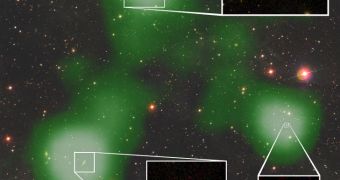Just yesterday, astronomers with the Royal Astronomical Society in the UK announced the discovery of a previously undocumented stream of gas estimated to be about 2.6 million light years long.
The stream, described as a bridge made up of atomic hydrogen gas, sits between two galaxies located at a distance of about 500 million light years from one another and is the largest structure of this kind thus far documented by science.
Thus, astronomers say that it is about 1 million light years longer than a similar gas stream that is located in the Virgo Cluster and that was identified with the help of telescopes at the Arecibo Observatory in Puerto Rico several years ago.
To help put things into perspective, astronomers with the Royal Astronomical Society in the UK explain that, apart from being surprisingly long, this bridge of atomic hydrogen gas is also mind-bogglingly heavy.
More precisely, data obtained with the help of the William E. Gordon Telescope at Puerto Rico's Arecibo Observatory indicates that its gas content is the equivalent of about 15 billion times the mass of our Sun.
“This was totally unexpected. We frequently see gas streams in galaxy clusters, where there are lots of galaxies close together, but to find something this long and not in a cluster is unprecedented,” study lead author Rhys Taylor says in a statement.
“We normally find gas inside galaxies, but here half of the gas – 15 billion times the mass of the Sun – is in the bridge. That’s far more than in the Milky Way and Andromeda galaxies combined!” the scientist goes on to explain.
This newly-discovered stream of gas is shown in green in the image next to this article. As detailed by Royal Astronomical Society specialists, it stretches from the large galaxy at the bottom left to the cluster at the top. One other galaxy at the bottom right also has one such structure attached to it.
For the time being, scientists cannot say how and why this massive bridge of molecular hydrogen gas came to form. It is believed that it came into being when the large galaxy passed fairly close to the cluster, an encounter that caused gas to be drawn out as the galaxy and the cluster separated.
One other possibility is that the large galaxy did not just pass by the group of smaller galaxies, but instead worked its way right through them. One such close encounter would have led to the release of enough gas to form the bridge. Future studies are expected to solve this enigma.

 14 DAY TRIAL //
14 DAY TRIAL //